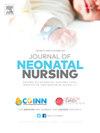影响护士将皮肤接触作为早产儿疼痛管理干预措施的因素
Q2 Nursing
引用次数: 0
摘要
目的 确定影响护士将皮肤接触(SSC)作为早产儿疼痛管理干预措施的环境和个人(个人和专业)因素。SSC是控制早产儿手术疼痛最有效的非药物干预措施之一。方法在这项国际横断面设计比较研究的二次分析中,共招募了202名护士并填写了自填问卷。结果与使用 SSC 控制疼痛相关的环境因素包括国家(p < 0.001)和工作班次(p < 0.001)。护士个人因素包括受教育程度(p <0.001)、孕产史(p <0.001)以及自我报告的皮肤接触实践[p <0.001](积极态度、教育和实施)。这些因素可能是早产新生儿植入 SSC 以控制手术疼痛时需要考虑的相关因素。本文章由计算机程序翻译,如有差异,请以英文原文为准。
Factors influencing nurses' practice of skin-to-skin contact as a pain management intervention for preterm infants
Purpose
To identify contextual as well as individual (personal and professional) factors influencing the practice of skin-to-skin contact (SSC) by nurses as a pain management intervention for preterm infants. SSC is among the most effective non-pharmacological interventions to manage procedural pain in preterm infants.
Methods
In this secondary analysis of a comparative international cross-sectional design study, 202 nurses were recruited and completed self-administered questionnaires. A mixed model was conducted.
Results
The contextual factors correlated with the use of SSC for pain management included the country (p < 0.001) and work shift (p < 0.001). Individual nurse factors were level of education (p < 0.001), motherhood history (p < 0.001) as well as self-reported skin-to-skin practices [p < 0.001] (positive attitudes, education, and implementation).
Conclusion
Many factors may contribute to explain the differences in the use of SSC for pain management by nurses. These factors could be of relevant to consider when implanting SSC to manage procedural pain in preterm neonates.
求助全文
通过发布文献求助,成功后即可免费获取论文全文。
去求助
来源期刊

Journal of Neonatal Nursing
Nursing-Pediatrics
CiteScore
2.00
自引率
0.00%
发文量
143
期刊介绍:
Aims & Scope: This is the practical, bimonthly, research-based journal for all professionals concerned with the care of neonates and their families, both in hospital and the community. It aims to support the development of the essential practice, management, education and health promotion skills required by these professionals. The JNN will provide a forum for the exchange of ideas and information between the range of professionals working in this field; promote cooperation between these professionals; facilitate partnership care with families; provide information and informed opinion; promote innovation and change in the care of neonates and their families; and provide an education resource for this important rapidly developing field.
 求助内容:
求助内容: 应助结果提醒方式:
应助结果提醒方式:


